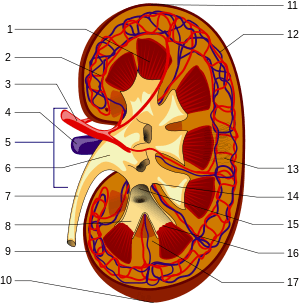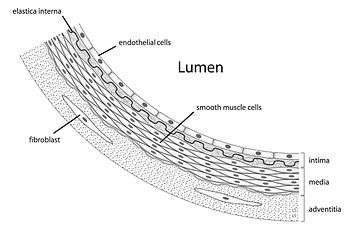Advanced glycation end-product
Advanced glycation end products (AGEs) are proteins or lipids that become glycated as a result of exposure to sugars.[1] They can be a factor in aging and in the development or worsening of many degenerative diseases, such as diabetes, atherosclerosis, chronic renal failure, and Alzheimer's disease.[2]
Effects
AGEs affect nearly every type of cell and molecule in the body and are thought to be one factor in aging and some age-related chronic diseases.[3][4][5] They are also believed to play a causative role in the vascular complications of diabetes mellitus.[6]
Under certain pathologic conditions, such as oxidative stress due to hyperglycemia in patients with diabetes,[7] and hyperlipidemia, AGE formation can be increased beyond normal levels. AGEs are now known to play a role as proinflammatory mediators in gestational diabetes as well.[8]
The animal and human evidence is that significant amounts of dietary advanced glycation end-products (dAGEs) are absorbed, and that dAGEs contribute to the body's burden of AGE, and are associated with diseases such as atherosclerosis and kidney disease.[9]
In the context of cardiovascular disease, AGEs can induce crosslinking of collagen which can cause vascular stiffening and entrapment of low-density lipoprotein particles (LDL) in the artery walls. AGEs can also cause glycation of LDL which can promote its oxidation.[10] Oxidized LDL is one of the major factors in the development of atherosclerosis.[11] Finally, AGEs can bind to RAGE (receptor for advanced glycation end products) and cause oxidative stress as well as activation of inflammatory pathways in vascular endothelial cells.[10][11]
In other diseases
The formation and accumulation of advanced glycation endproducts (AGEs) has been implicated in the progression of age-related diseases.[12] AGEs have been implicated in Alzheimer's Disease,[13] cardiovascular disease,[14] and stroke.[15] The mechanism by which AGEs induce damage is through a process called cross-linking that causes intracellular damage and apoptosis.[16] They form photosensitizers in the crystalline lens,[17] which has implications for cataract development.[18] Reduced muscle function is also associated with AGEs.[19]
Pathology
AGEs have a range of pathological effects, such as:[20][21]
- Increased vascular permeability.
- Increased arterial stiffness
- Inhibition of vascular dilation by interfering with nitric oxide.
- Oxidizing LDL.
- Binding cells—including macrophage, endothelial, and mesangial—to induce the secretion of a variety of cytokines.
- Enhanced oxidative stress.
Reactivity
Proteins are usually glycated through their lysine residues.[22] In humans, histones in the cell nucleus are richest in lysine, and therefore form the glycated protein N(6)-Carboxymethyllysine (CML).[22]
A receptor (biochemistry) nicknamed RAGE, from receptor for advanced glycation end products, is found on many cells, including endothelial cells, smooth muscle, cells of the immune system from tissue such as lung, liver, and kidney. This receptor, when binding AGEs, contributes to age- and diabetes-related chronic inflammatory diseases such as atherosclerosis, asthma, arthritis, myocardial infarction, nephropathy, retinopathy, periodontitis and neuropathy.[23] The pathogenesis of this process hypothesized to activation of the nuclear factor kappa B (NF-κB) following AGE binding. NF-κB controls several genes which are involved in inflammation.
Clearance
In clearance, or the rate at which a substance is removed or cleared from the body, it has been found that the cellular proteolysis of AGEs—the breakdown of proteins—produces AGE peptides and "AGE free adducts" (AGE adducts bound to single amino acids). These latter, after being released into the plasma, can be excreted in the urine.[24]

Nevertheless, the resistance of extracellular matrix proteins to proteolysis renders their advanced glycation end products less conducive to being eliminated.[24] While the AGE free adducts are released directly into the urine, AGE peptides are endocytosed by the epithelial cells of the proximal tubule and then degraded by the endolysosomal system to produce AGE amino acids. It is thought that these acids are then returned to the kidney's inside space, or lumen, for excretion. [20] AGE free adducts are the major form through which AGEs are excreted in urine, with AGE-peptides occurring to a lesser extent[20] but accumulating in the plasma of patients with chronic kidney failure.[24]
Larger, extracellularly derived AGE proteins cannot pass through the basement membrane of the renal corpuscle and must first be degraded into AGE peptides and AGE free adducts. Peripheral macrophage[20] as well as liver sinusoidal endothelial cells and Kupffer cells [25] have been implicated in this process, although the real-life involvement of the liver has been disputed. [26]

Large AGE proteins unable to enter the Bowman's capsule are capable of binding to receptors on endothelial and mesangial cells and to the mesangial matrix.[20] Activation of RAGE induces production of a variety of cytokines, including TNFβ, which mediates an inhibition of metalloproteinase and increases production of mesangial matrix, leading to glomerulosclerosis[21] and decreasing kidney function in patients with unusually high AGE levels.
Although the only form suitable for urinary excretion, the breakdown products of AGE—that is, peptides and free adducts—are more aggressive than the AGE proteins from which they are derived, and they can perpetuate related pathology in diabetic patients, even after hyperglycemia has been brought under control.[20]
Some AGEs have innate catalytic oxidative capacity, while activation of NAD(P)H oxidase through activation of RAGE and damage to mitochondrial proteins leading to mitochondrial dysfunction can also induce oxidative stress. Because perpetuation can result through AGEs' oxidative effects, concurrent treatment with antioxidants might help halt the cycle.[21] In the end, effective clearance is necessary, and those suffering AGE increases because of kidney dysfunction might require a kidney transplant.[20]
In diabetics who have an increased production of an AGE, kidney damage reduces the subsequent urinary removal of AGEs, forming a positive feedback loop that increases the rate of damage. A 1997 study concluded that adding sugar to egg whites causes diabetics to be 200 times more AGE immunoreactive.[27]
Potential therapy

AGEs are the subject of ongoing research. There are three therapeutic approaches: preventing the formation of AGEs, breaking crosslinks after they are formed and preventing their negative effects.
Compounds that have been found to inhibit AGE formation in the laboratory include Vitamin C,[28] benfotiamine, pyridoxamine, alpha-lipoic acid,[29] taurine,[30] pimagedine,[31] aspirin,[32][33] carnosine,[34] metformin,[35] pioglitazone,[35] and pentoxifylline.[35]
Studies in rats and mice have found that natural phenols such as resveratrol and curcumin can prevent the negative effects of the AGEs.[36][37]
Compounds that are thought to break some existing AGE crosslinks include Alagebrium (and related ALT-462, ALT-486, and ALT-946)[38] and N-phenacyl thiazolium bromide.[39] One in vitro study shows that rosmarinic acid out performs the AGE breaking potential of ALT-711. [40]

There is, however, no agent known that can break down the most common AGE, glucosepane, which appears 10 to 1,000 times more common in human tissue than any other cross-linking AGE.[41][42]
Some chemicals, on the other hand, like aminoguanidine, might limit the formation of AGEs by reacting with 3-deoxyglucosone.[23]
See also
References
- ↑ "American Heart Association". Retrieved 5 May 2016.
- ↑ Vistoli, G; De Maddis, D; Cipak, A; Zarkovic, N; Carini, M; Aldini, G (Aug 2013). "Advanced glycoxidation and lipoxidation end products (AGEs and ALEs): an overview of their mechanisms of formation.". Free Radic Res. 47: Suppl 1:3–27. doi:10.3109/10715762.2013.815348. PMID 23767955.
- ↑ Glenn, J.; Stitt, A. (2009). "The role of advanced glycation end products in retinal ageing and disease". Biochimica et Biophysica Acta. 1790 (10): 1109–1116. doi:10.1016/j.bbagen.2009.04.016. PMID 19409449.
- ↑ Semba, R. D.; Ferrucci, L.; Sun, K.; Beck, J.; Dalal, M.; Varadhan, R.; Walston, J.; Guralnik, J. M.; Fried, L. P. (2009). "Advanced glycation end products and their circulating receptors predict cardiovascular disease mortality in older community-dwelling women". Aging clinical and experimental research. 21 (2): 182–190. doi:10.1007/BF03325227. PMC 2684987
 . PMID 19448391.
. PMID 19448391. - ↑ Semba, R.; Najjar, S.; Sun, K.; Lakatta, E.; Ferrucci, L. (2009). "Serum carboxymethyl-lysine, an advanced glycation end product, is associated with increased aortic pulse wave velocity in adults". American Journal of Hypertension. 22 (1): 74–79. doi:10.1038/ajh.2008.320. PMC 2637811
 . PMID 19023277.
. PMID 19023277. - ↑ Yan, S. F.; D'Agati, V.; Schmidt, A. M.; Ramasamy, R. (2007). "Receptor for Advanced Glycation Endproducts (RAGE): a formidable force in the pathogenesis of the cardiovascular complications of diabetes & aging". Current molecular medicine. 7 (8): 699–710. doi:10.2174/156652407783220732. PMID 18331228.
- ↑ Brownlee, M (June 2005). "The pathobiology of diabetic complications: a unifying mechanism.". Diabetes. 54 (6): 1615–25. doi:10.2337/diabetes.54.6.1615. PMID 15919781.
- ↑ Pertyńska-Marczewska, M; Głowacka, E; Sobczak, M; Cypryk, K; Wilczyński, J (February 2009). "Glycation endproducts, soluble receptor for advanced glycation endproducts and cytokines in diabetic and non-diabetic pregnancies.". American journal of reproductive immunology (New York, N.Y. : 1989). 61 (2): 175–82. doi:10.1111/j.1600-0897.2008.00679.x. PMID 19143681.
- ↑ Uribarri, J; Woodruff, S; Goodman, S; Cai, W; Chen, X; Pyzik, R; Yong, A; Striker, GE; Vlassara, H (June 2010). "Advanced glycation end products in foods and a practical guide to their reduction in the diet". Journal of the American Dietetic Association. 110 (6): 911–16.e12. doi:10.1016/j.jada.2010.03.018. PMC 3704564
 . PMID 20497781.
. PMID 20497781. - 1 2 Prasad, Anand; Bekker, Peter; Tsimikas, Sotirios (2012-08-01). "Advanced glycation end products and diabetic cardiovascular disease". Cardiology in Review. 20 (4): 177–183. doi:10.1097/CRD.0b013e318244e57c. ISSN 1538-4683. PMID 22314141.
- 1 2 Di Marco, Elyse; Gray, Stephen P.; Jandeleit-Dahm, Karin (2013-01-01). "Diabetes alters activation and repression of pro- and anti-inflammatory signaling pathways in the vasculature". Frontiers in Endocrinology. 4: 68. doi:10.3389/fendo.2013.00068. ISSN 1664-2392. PMC 3672854
 . PMID 23761786.
. PMID 23761786. - ↑ Tan, KC; Chow, WS; Lam, JC; Lam, B; Bucala, R; Betteridge, J; Ip, MS (March 2006). "Advanced glycation endproducts in nondiabetic patients with obstructive sleep apnea.". Sleep. 29 (3): 329–33. PMID 16553018.
- ↑ Srikanth, V; Maczurek, A; Phan, T; Steele, M; Westcott, B; Juskiw, D; Münch, G (May 2011). "Advanced glycation endproducts and their receptor RAGE in Alzheimer's disease.". Neurobiology of Aging. 32 (5): 763–77. doi:10.1016/j.neurobiolaging.2009.04.016. PMID 19464758.
- ↑ Simm, A; Wagner, J; Gursinsky, T; Nass, N; Friedrich, I; Schinzel, R; Czeslik, E; Silber, RE; Scheubel, RJ (July 2007). "Advanced glycation endproducts: a biomarker for age as an outcome predictor after cardiac surgery?". Experimental Gerontology. 42 (7): 668–75. doi:10.1016/j.exger.2007.03.006. PMID 17482402.
- ↑ Zimmerman GA, Meistrell M 3rd, Bloom O, Cockroft KM, Bianchi M, Risucci D, Broome J, Farmer P, Cerami A, Vlassara H, et al. Neurotoxicity of advanced glycation endproducts during focal stroke and neuroprotective effects of aminoguanidine. Proceedings of the National Academy of Sciences of the United States of America 1995 Apr 25;92(9):3744-8.
- ↑ Shaikh S, Nicholson LF. Advanced glycation end products induce in vitro cross-linking of alpha-synuclein and accelerate the process of intracellular inclusion body formation. J Neurosci Res. 2008 Jul;86(9):2071-82.
- ↑ Fuentealba D, Friguet B, Silva E. Advanced glycation endproducts induce photocrosslinking and oxidation of bovine lens proteins through type-I mechanism. Photochem Photobiol. 2009 Jan-Feb;85(1):185-94.
- ↑ Gul A, Rahman MA, Hasnain SN. Role of fructose concentration on cataractogenesis in senile diabetic and non-diabetic patients. Graefes Arch Clin Exp Ophthalmol. 2009 Jun;247(6):809-14.
- ↑ Haus, JM; Carrithers, JA; Trappe, SW; Trappe, TA (December 2007). "Collagen, cross-linking, and advanced glycation end products in aging human skeletal muscle.". Journal of applied physiology (Bethesda, Md. : 1985). 103 (6): 2068–76. doi:10.1152/japplphysiol.00670.2007. PMID 17901242.
- 1 2 3 4 5 6 7 Gugliucci A, Bendayan M (1996). "Renal fate of circulating advanced glycated end products (AGE): evidence for reabsorption and catabolism of AGE peptides by renal proximal tubular cells". Diabetologia. 39 (2): 149–60. doi:10.1007/BF00403957. PMID 8635666.
- 1 2 3 Yan HD, Li XZ, Xie JM, Li M (2007). "Effects of advanced glycation end products on renal fibrosis and oxidative stress in cultured NRK-49F cells". Chin. Med. J. 120 (9): 787–93. PMID 17531120.
- 1 2 Ansari NA, Moinuddin, Ali R (2011). "Glycated lysine residues: a marker for non-enzymatic protein glycation in age-related diseases". DISEASE MARKERS. 30 (6): 317–324. doi:10.3233/DMA-2011-0791. PMC 3825483
 . PMID 21725160.
. PMID 21725160. - 1 2 Wells-Knecht KJ, Zyzak DV, Litchfield JE, Thorpe SR, Baynes JW (1995). "Mechanism of autoxidative glycosylation: identification of glyoxal and arabinose as intermediates in the autoxidative modification of proteins by glucose". Biochemistry. 34 (11): 3702–9. doi:10.1021/bi00011a027. PMID 7893666.
- 1 2 3 Gugliucci A, Mehlhaff K, Kinugasa E, et al. (2007). "Paraoxonase-1 concentrations in end-stage renal disease patients increase after hemodialysis: correlation with low molecular AGE adduct clearance". Clin. Chim. Acta. 377 (1–2): 213–20. doi:10.1016/j.cca.2006.09.028. PMID 17118352.
- ↑ Smedsrød B, Melkko J, Araki N, Sano H, Horiuchi S (1997). "Advanced glycation end products are eliminated by scavenger-receptor-mediated endocytosis in hepatic sinusoidal Kupffer and endothelial cells". Biochem. J. 322 (Pt 2): 567–73. PMC 1218227
 . PMID 9065778.
. PMID 9065778. - ↑ Svistounov D, Smedsrød B (2004). "Hepatic clearance of advanced glycation end products (AGEs)—myth or truth?". J. Hepatol. 41 (6): 1038–40. doi:10.1016/j.jhep.2004.10.004. PMID 15582139.
- ↑ Koschinsky, T; He, CJ; Mitsuhashi, T; Bucala, R; Liu, C; Buenting, C; Heitmann, K; Vlassara, H (Jun 10, 1997). "Orally absorbed reactive glycation products (glycotoxins): an environmental risk factor in diabetic nephropathy.". Proceedings of the National Academy of Sciences of the United States of America. 94 (12): 6474–9. doi:10.1073/pnas.94.12.6474. PMC 21074
 . PMID 9177242.
. PMID 9177242. - ↑ Hira Zafar (26 June 2012). "Inhibition of protein glycation and advanced glycation end products by ascorbic acid". African Journal of Biotechnology. 11 (51). doi:10.5897/AJB11.4172.
- ↑ Abdul, HM; Butterfield, DA (Feb 1, 2007). "Involvement of PI3K/PKG/ERK1/2 signaling pathways in cortical neurons to trigger protection by cotreatment of acetyl-L-carnitine and alpha-lipoic acid against HNE-mediated oxidative stress and neurotoxicity: implications for Alzheimer's disease.". Free radical biology & medicine. 42 (3): 371–84. doi:10.1016/j.freeradbiomed.2006.11.006. PMC 1808543
 . PMID 17210450.
. PMID 17210450. - ↑ Nandhini AT, Thirunavukkarasu V, Anuradha CV (August 2005). "Taurine prevents collagen abnormalities in high fructose-fed rats" (PDF). Indian J. Med. Res. 122 (2): 171–7. PMID 16177476.
- ↑ A. Gugliucci, "Sour Side of Sugar, A Glycation Web Page Archived July 1, 2007, at the Wayback Machine.
- ↑ "Aspirin inhibits the formation of... preview & related info". Mendeley. doi:10.1016/j.diabres.2006.12.024. Retrieved 2013-11-13.
- ↑ Bucala R, Cerami A (1992). "Advanced glycosylation: chemistry, biology, and implications for diabetes and aging". Adv. Pharmacol. Advances in Pharmacology. 23: 1–34. doi:10.1016/S1054-3589(08)60961-8. ISBN 9780120329236. PMID 1540533.
- ↑ Guiotto A, Calderan A, Ruzza P, Borin G (2005). "Carnosine and carnosine-related antioxidants: a review". Current Medicinal Chemistry. 12 (20): 2293–2315. doi:10.2174/0929867054864796. PMID 16181134.
- 1 2 3 "Novel inhibitors of advanced glycation endproducts". Arch. Biochem. Biophys. 419 (1): 63–79. 2013-03-25. doi:10.1016/j.abb.2003.08.009. PMID 14568010.
- ↑ Mizutani, K; Ikeda, K; Yamori, Y (Jul 21, 2000). "Resveratrol inhibits AGEs-induced proliferation and collagen synthesis activity in vascular smooth muscle cells from stroke-prone spontaneously hypertensive rats.". Biochemical and Biophysical Research Communications. 274 (1): 61–7. doi:10.1006/bbrc.2000.3097. PMID 10903896.
- ↑ Tang Y (May 2014). "Curcumin eliminates the effect of advanced glycation end-products (AGEs) on the divergent regulation of gene expression of receptors of AGEs by interrupting leptin signaling.". Lab Invest. 94 (5): 503–16. doi:10.1038/labinvest.2014.42. PMID 24614199.
- ↑ "Academic Journals formerly published by NPG". Nature.com. Retrieved 2013-11-13.
- ↑ Vasan, S; Zhang, X; Zhang, X; Kapurniotu, A; Bernhagen, J; Teichberg, S; Basgen, J; Wagle, D; Shih, D; Terlecky, I; Bucala, R; Cerami, A; Egan, J; Ulrich, P (Jul 18, 1996). "An agent cleaving glucose-derived protein crosslinks in vitro and in vivo.". Nature. 382 (6588): 275–8. doi:10.1038/382275a0. PMID 8717046.
- ↑ Daniel Jean; Maryse Pouligon; Claude Dalle. "Evaluation in vitro of AGE-crosslinks breaking ability of rosmarinic acid" (PDF). Glycative Stress Research.
- ↑ Monnier, V. M., Mustata, G. T., Biemel, K. L., Reihl, O., Lederer, M. O., Zhenyu, D. et al. (2005). "Cross-linking of the extracellular matrix by the maillard reaction in aging and diabetes: An update on "a puzzle nearing resolution"". Annals of the New York Academy of Sciences. 1043: 533–544. doi:10.1196/annals.1333.061. PMID 16037276.
- ↑ Furber, J.D. (2006). "Extracellular glycation crosslinks: Prospects for removal". Rejuvenation Research. Elsevier Inc. 9 (2): 274–278. doi:10.1089/rej.2006.9.274. PMID 16706655.
External links
- How and Why to Prevent AGE Damage, Life Enhancement Website